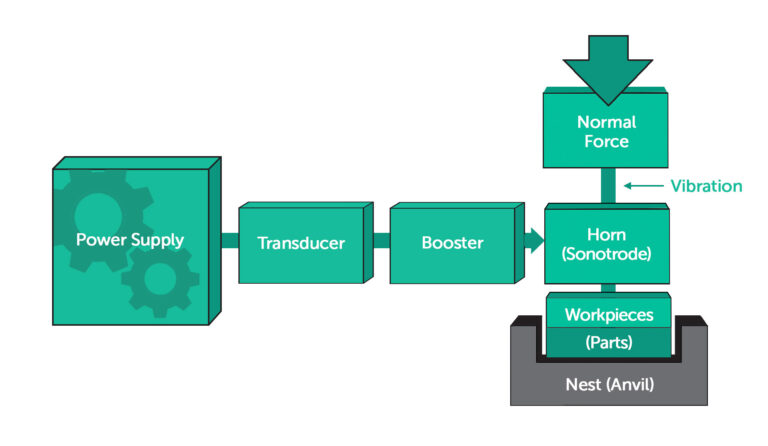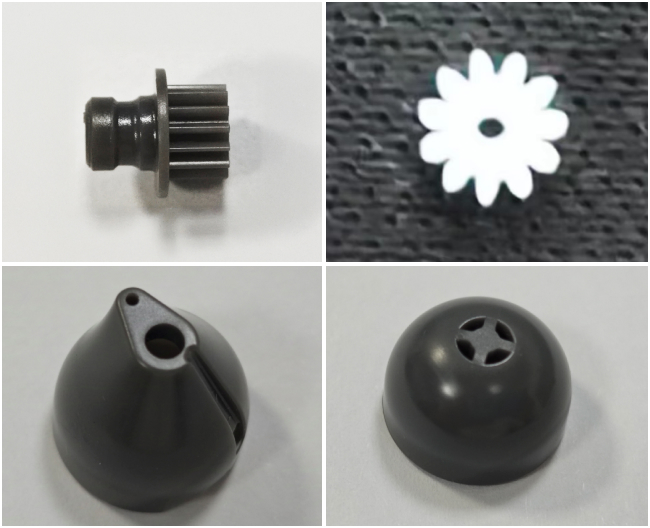Time to read: 4 min
While you may not be familiar with bimetallic strips, you likely have encountered thermometers that utilize them. Bimetallic strips are most often used in modern electronic and mechanical devices such as thermal circuit breakers, thermometers, temperature-sensitive switches, fire alarms, timers, relays, and motor starters. This article discusses what a bimetallic strip is, where it originated, and how this technology works.
What is a Bimetallic Strip?
A bimetallic strip is composed of two dissimilar metals joined together, usually in the form of two strips or two ribbons. The two metals are specifically dissimilar in terms of their electrical conductivity, thermal conductivity, and mechanical properties. When the strip is exposed to heat, the two dissimilar metals expand at different rates, and the resulting bending is utilized to determine the value of the temperature change. This simplicity makes the bimetallic strip an ideal component for a wide variety of applications.
How is a Bimetallic Strip Constructed?
A bimetallic strip consists of two thin strips of metal that are typically brass, copper, or steel. The strips are layered on top of each other, with one end joined and the other end free, allowing the assembly to bend and respond to temperature changes. Typically the two strips or ribbons that compose a bimetallic strip are secured together by welding or soldering.
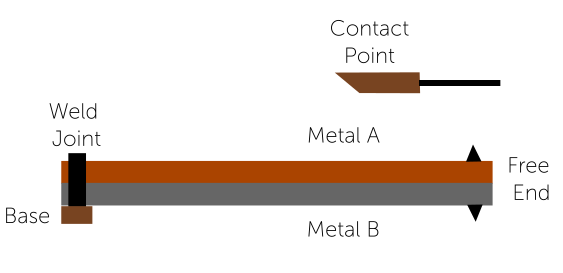
How Does a Bimetallic Strip Work?
The two dissimilar metals in bimetallic strips are chosen based on the application and the desired properties. The operating mechanism that allows for movement of the bimetallic strip is from Thermodynamics, and the equation for linear thermal expansion helps to understand it:
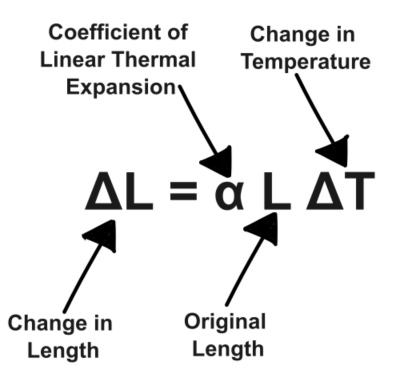
Now, if you have two metal strips exposed to the same change in temperature and the same original length, but they have different coefficients of linear thermal expansion, you will see varying changes in length.
For an increase in temperature, the metal with the higher coefficient of thermal expansion will grow more than the other strip, causing the strip to bend towards the metal with the lower thermal coefficient.
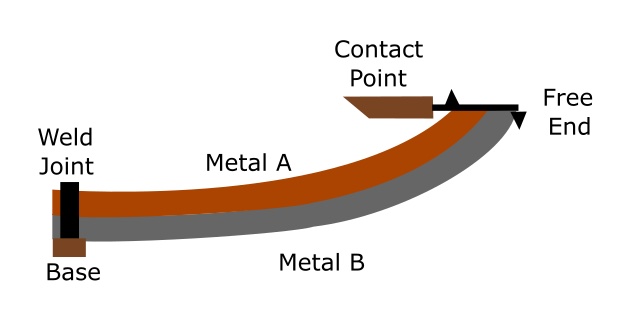
For a decrease in temperature, the strip with the higher coefficient of linear thermal expansion decreases in length more, causing the strip to bend towards the metal with the higher thermal coefficient.
Now, the only operating mechanism for the movement of a bimetallic strip is the application of heat — the two metal strips are joined together, and the bending is caused by the difference in thermal expansion coefficients of the two metals. Basically, the thermal energy is converted to mechanical energy and a resulting displacement. In other words, when one metal expands more than the other due to a change in temperature, the strip bends or flexes to the contact point. That contact point is a bimetallic strip sensor that activates a switch and sends a signal to a control device or circuit.
Checkout Fictiv’s CNC Machining capabilities
Important Physical Properties of Bimetallic Strip Materials
When designing a bimetallic strip for any application, it is important to evaluate certain physical properties of the proposed materials:
- Coefficient of thermal expansion (how the material responds to changes in temperature)
- Modulus of elasticity (the ratio of stress to strain for a material undergoing elastic deformation)
- Maximum operating temperature (the maximum temperature the material can operate at without losing significant mechanical properties or permanently deforming)
- Electrical conductivity (especially for electrical applications)
- Stiffness and ductility
Common Bimetallic Strip Designs
Evaluating material properties is an important starting point for bimetallic strip design. Understanding the most prevalent designs is also a benefit at the outset because best practice is to have knowledge of previous designs in your area before creating something new — knowing what others have explored before you explore it yourself can save a lot of time and struggle.
The most common bimetallic strip designs are disc, ribbon, and coil designs. Of those, the disc design is the most prevalent, which consists of two metal discs stacked together. Ribbon designs consist of two metal strips joined together, and coils consist of two metal strips that are wound together into a coil. Each of these designs has its advantages and disadvantages, so the best design for a particular application should be chosen based on your requirements.
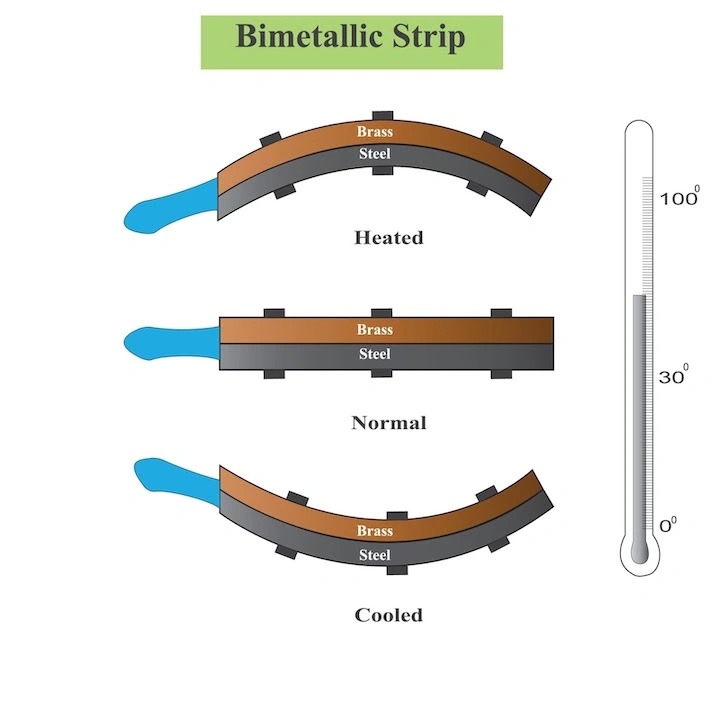
Common Applications for a Bimetallic Strip
The most common use for a bimetallic strip is as a temperature-sensitive switch. This type of switch is used in a wide range of applications, including thermostats, refrigerators, and other household appliances. But bimetallic strips are also used in a variety of mechanical applications. They can be used as a spring to provide tension or adjust the tension on a part. They can also be used to make a variety of mechanical linkages, such as a bell crank, which changes the direction of a force.
Bimetallic strips are also used in electrical applications, often as relays, which are electrical switches that control circuits. They can also be used as a current-limiting device, a type of resistor that limits the amount of current flowing through a circuit. Bimetallic strips are also used in a variety of other applications, including heat-sensitive switches, thermal fuses, and temperature-sensitive resistance elements.
In all of these applications, the two metals are carefully chosen based on their properties in order to achieve the desired result.
Fictiv: Complex Parts at Ridiculous Speeds
Whether you’re looking for a bimetallic strip manufacturer, or someone to manufacture a housing for a bimetallic strip, we have you covered! Fictiv delivers even the most complex parts 2-5X faster than your average machine shop. We have a proven track record of delivering 95.4% of orders on time and to spec, thanks to our network of highly-vetted partners, on-site quality engineers, and robust quality management system. And, you get an inspection report with every part.
Create an account and upload your design today to see what our instant online cnc quote process, DFM feedback, and intelligent platform can do for you.









